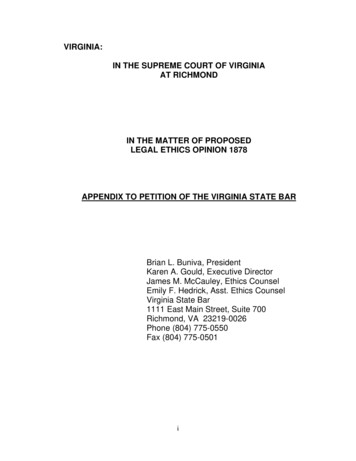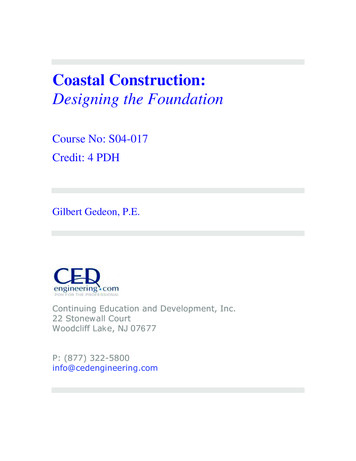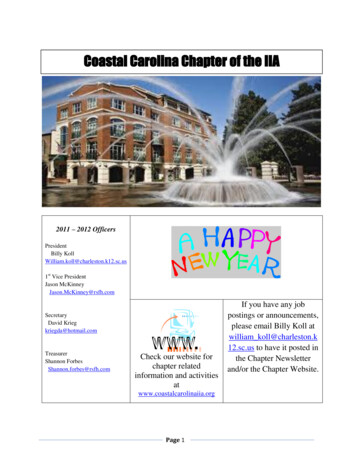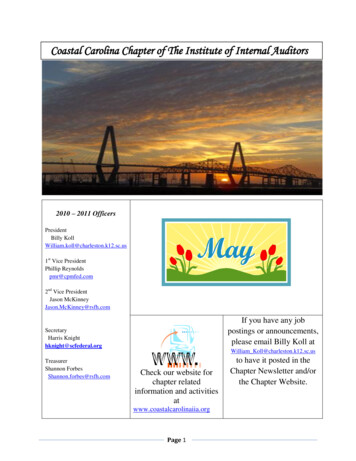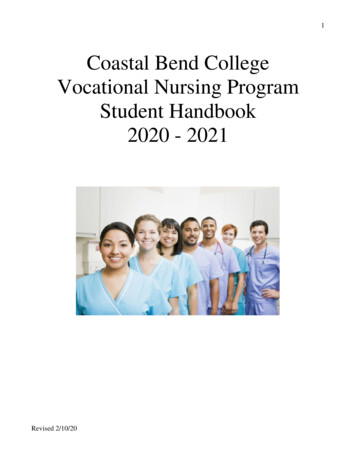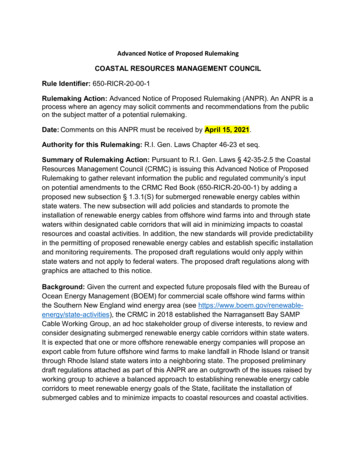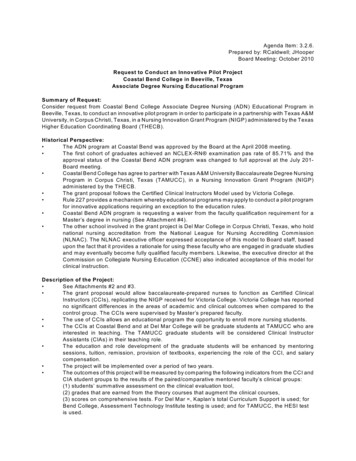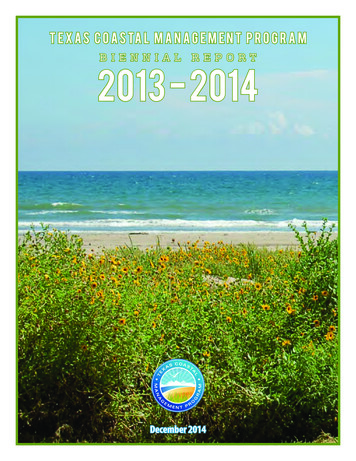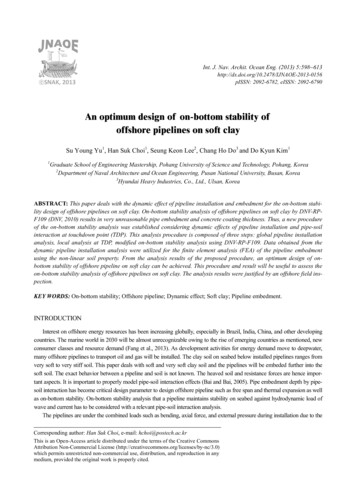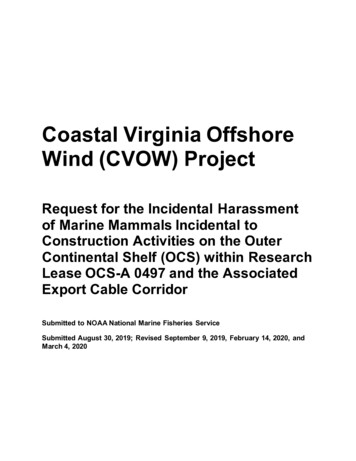
Transcription
Coastal Virginia OffshoreWind (CVOW) ProjectRequest for the Incidental Harassmentof Marine Mammals Incidental toConstruction Activities on the OuterContinental Shelf (OCS) within ResearchLease OCS-A 0497 and the AssociatedExport Cable CorridorSubmitted to NOAA National Marine Fisheries ServiceSubmitted August 30, 2019; Revised September 9, 2019, February 14, 2020, andMarch 4, 2020
Coastal Virginia Offshore Wind Project - Request for the Incidental Harassment of Marine MammalsTable of Contents1.Introduction.12.Description of Specified Activity.33.2.1HRG Equipment Use.52.2Cable-lay Activities .62.3Pile Driving .7Dates, Duration, and Specif ic Geographic Region .83.1Dates and Duration.83.2Specif ic Geographic Region.84.Species and Numbers of Marine Mammals .85.Affected Species Status and Distribution. 115.1Toothed Whales (Odontoceti). 125.1.1 Sperm Whale (Physeter macrocephalus) – Endangered . 125.1.2 Harbor Porpoise (Phocoena phocoena) – Non-Strategic. 135.1.3 Bottlenose Dolphin (Tursiops truncatus) – Non-Strategic Western NorthAtlantic Offshore Stock; Non-Endangered, Strategic Southern CoastalMigratory Stock . 145.1.4 Common Dolphin (Delphinus delphis) – Non-Strategic. 155.1.5 White-Sided Dolphin (Lagenorhynchus acutus) – Non-Strategic. 155.1.6 Atlantic Spotted Dolphin (Stenella frontalis) – Non-Strategic. 165.1.7 Risso’s Dolphin (Grampus griseus) – Non-Strategic . 165.1.8 Long-Finned and Short-Finned Pilot Whale (Globicephala melas andGlobicephala macrorhynchus) – Non-Endangered, Strategic Western NorthAtlantic Stocks . 175.2Baleen Whales (Mysticeti). 185.2.1 North Atlantic Right Whale (Eubalaena glacialis) – Endangered. 185.2.2 Humpback Whale (Megaptera novaeangliae) – Non-Endangered / NonStrategic for West Indies Distinct Population Segment. 205.2.3 Fin Whale (Balaenoptera physalus) – Endangered. 215.2.4 Sei Whale (Balaenoptera borealis) – Endangered. 225.2.5 Minke Whale (Balaenoptera acutorostrata) – Non-Strategic. 226.Type of Incidental Taking Requested . 237.Take Estimates for Marine Mammals . 237.1Basis for Estimating Numbers of Marine Mammals that Might be “Taken byHarassment” f rom Pile Driving . 24i
Coastal Virginia Offshore Wind Project - Request for the Incidental Harassment of Marine Mammals7.1.1 Sound Propagation Model. 247.1.2 Calculation of Range to Regulatory Thresholds . 247.1.3 Estimate of Numbers of Marine Mammals that Might be “Taken byHarassment” f rom Pile Driving . 277.2Total Requested Level A and B Harassment Take . 288.Anticipated Impacts of the Activity. 329.Anticipated Impacts on Subsistence Uses. 3210.Anticipated Impacts on Habitat. 3211.Anticipated Effects of Habitat Impacts on Marine Mammals . 3212.Mitigation Measures . 3212.1 Vessel Strike Avoidance Procedures . 3312.2 Seasonal Operating Requirements. 3412.3 Exclusion and Monitoring Zone Implementation. 3412.4 Visual Monitoring Program . 3412.5 Pre-Clearance of the Exclusion Zones . 3512.6 Soft-Start Procedures. 3612.7 Shut-Down Procedures. 3613.Arctic Plan of Cooperation. 3714.Monitoring and Reporting . 3714.1 Monitoring . 3714.2 Reporting . 3715.Suggested Means of Coordination Research. 3716.List of Preparers . 3817.Ref erences . 39ii
Coastal Virginia Offshore Wind Project - Request for the Incidental Harassment of Marine MammalsList of TablesTable 2-1.M - Weighted Permanent Threshold Shift (PTS) and Temporary Threshold Shift (TTS)Criteria and Functional Hearing Range for Marine Mammals (NOAA Fisheries 2018a). .4Table 2-2.Summary of HRG Equipment Proposed for Use.5Table 4-1.Marine Mammals Known to Occur in the Marine Waters in Coastal and Offshore Virginia. .9Table 7-1.Maximum Radii (m) that Correspond to the Peak SPLs for Impact Pile Driving. 25Table 7-2.Radii (m) of M-Weighted SELcum Contours for Impact Pile Driving. 25Table 7-3.Radii (m) to 160 dBrms90 SPL (Level B Harassment) for Impact Pile Driving . 26Table 7-4.Pile Driving Activity ZOIs for Level A Harassment Based on Maximum Distances. 27Table 7-5.Pile Driving Activity Maximum Distances and ZOIs for Level B Harassment. 27Table 7-6.Pile Driving Marine Mammal Density and Estimated Level A Harassment Take Numbersby Mitigation Type. 29Table 7-7.Pile Driving Marine Mammal Density and Estimated Level B Harassment Take Numbersby Mitigation Type. 30Table 7-8.Total Estimated Level A and B Harassment Take Numbers . 31List of FiguresFigure 1-1.Project Location. .2List of AppendicesAppendix A – Acoustic Modeling Reportiii
Coastal Virginia Offshore Wind Project - Request for the Incidental Harassment of Marine MammalsACRONYMS AND ABBREVIATIONSPamicroPascalAFTTAtlantic Fleet Training and TestingApplicantVirginia Electric and Power Company, d/b/a Dominion Energy VirginiaBOEMBureau of Ocean Energy ManagementCFRCode of Federal RegulationsCmcentimeterCVOWCoastal Virginia Offshore WinddBdecibelDMADynamic Management AreaDominion EnergyDominion Energy VirginiaDPdynamic positioningECMEnvironmental Compliance MonitorEISEnvironmental Impact StatementESAEndangered Species ActEODExplosive Ordnance DisposalFtf ootGPSglobal positioning systemHDDhorizontal directional drillingHFhigh-f requencyHRGhigh-resolution geophysicalHzhertzIHAIncidental Harassment AuthorizationKgkilogramsKmkilometerkm/hkilometer per hourkHzkilohertzLFlow-f requencyMmeterMBESmultibeam echo sounderMECmunitions and explosives of concernMFmid-f requencyMimileMMPAMarine Mammal Protection ActNOAANational Oceanic and Atmospheric AdministrationNOAA FisheriesNational Marine Fisheries ServiceOCSOuter Continental ShelfOEISOverseas Environmental Impact Statementiv
Coastal Virginia Offshore Wind Project - Request for the Incidental Harassment of Marine MammalsPAMPassive Acoustic MonitoringPBRPotential Biological RemovalPmpeak shock wave pressurePSOProtected Species ObserverPTSpermanent threshold shiftRAPResearch Activities PlanROVremotely operated vehicleRMSroot mean squareSELsound exposure levelSELcumcumulative SELSMASeasonal Management AreaSVPsound velocity profileTSStotal suspended solidsTTStemporary threshold shiftUSBLultra-short baselineU.S. NavyU.S. Department of the NavyUMEUnusual Mortality EventZOIZone of Inf luencev
Coastal Virginia Offshore Wind Project - Request for the Incidental Harassment of Marine Mammals1.IntroductionVirginia Electric and Power Company (the Applicant), d/b/a Dominion Energy Virginia (Dominion Energy),is proposing to conduct several activities off the coast of Virginia in the area of Research Lease ofSubmerged Lands for Renewable Energy Activities on the Outer Continental Shelf (OCS) Offshore Virginia(Lease No. OCS-A-0497) (the Lease Area; Figure 1-1) and along the 43-kilometer (km) (27-mile [mi]) ExportCable Corridor in support of the Coastal Virginia Offshore Wind (CVOW) Project. The Applicant submitsthis request f or Incidental Harassment Authorization (IHA) pursuant to Section 101(a)(5) of the MarineMammal Protection Act (MMPA) and 50 Code of Federal Regulations (CFR) § 216 Subpart I to allow forthe incidental harassment of small numbers of marine mammals resulting from pile driving associated withinstallation of the wind turbine generator (WTG) foundations. The objective of the pile driving activities is tosupport installation of the WTG f oundations (monopiles). Underwater sound resulting from Dominion’s piledriving activities have the potential to result in incidental take of marine mammals in the form of harassmentand/or take.The regulations set f orth in Section 101(a) (5) of the MMPA and 50 CFR § 216 Subpart I allow f or thepotential take by incidental harassment of marine mammals by a specific activity if the activity is f ound tohave a negligible impact on the species or stock(s) of marine mammals. In order f or the National Oceanicand Atmospheric Administration’s (NOAA’s) National Marine Fisheries Service (NOAA Fisheries) toconsider authorizing the taking by U.S. citizens of small numbers of marine mammals incidental to aspecified activity (other than commercial f ishing), a written request must be submitted to the AssistantAdministrator. Such a request is detailed in the following sections.1
Coastal Virginia Offshore Wind Project - Request for the Incidental Harassment of Marine MammalsFigure 1-1.Project Location.2
Coastal Virginia Offshore Wind Project - Request for the Incidental Harassment of Marine Mammals2.Description of Specified ActivityAll proposed activities included in this application will be conducted in the marine environment in the CVOWLease Area and along the Export Cable Corridor between the Lease Area and the Virginia shoreline, locatedin the lower Chesapeake Bay (see Figure 1-1).The potential ef fects of underwater noise resulting in potential take by incidental harassment of marinemammals are f ederally managed by NOAA Fisheries under the MMPA to minimize the potential for bothharm and harassment. Under the MMPA, Level A harassment is statutorily defined as any act of pursuit,torment, or annoyance that has the potential to injure a marine mammal or marine mammal stock in thewild; the actionable sound pressure level is not identified in the statute since the statute was written priorto the understanding of acoustic ef fects on marine mammals . The regulatory levels are contained inupdated NOAA acoustic guidance (NOAA Fisheries 2016 and 2018a). The def inition of Level B harassmentwas amended to be def ined as any act that disturbs or is likely to disturb a marine mammal or marinemammal stock in the wild by causing disruption of natural behavioral patterns, including, but not limited to,migration, surfacing, nursing, breeding, f eeding, or sheltering, to a point where such behavioral patternsare abandoned or significantly altered. Additionally, marine mammal stocks are defined as strategic or nonstrategic; a strategic stock is one which the level of direct human-caused mortality exceeds the potentialbiological removal (PBR) level (maximum number of animals, not including in natural mortalities that maybe removed annually from a marine mammal stock while allowing that stock to reach or maintain its optimalsustainable population level). This level is something that NOAA Fisheries considers in its designation oflisting status. Mortalities are tracked via post-activity reporting to National Marine Fisheries Service (NOAAFisheries).The 2016 Acoustic Guidance (NOAA Fisheries 2016) f ormalized a practice in which NOAA Fisheriesconsidered the onset of permanent threshold shif t (PTS), which is an auditory injury, as a Level Aharassment. The guidance also def ines temporary threshold shif t (TTS) and associated thresholds,although these are not currently associated with a level of take under the current NOAA Fisheries guidance.Level A harassment is said to occur as a result of exposure to high noise levels and onset of PTS. Underthis NOAA Fisheries guidance, a systemwas established whereby marine mammalspecies were organizedinto 5 f unctional hearing groups based on their ability to detect certain sound f requencies. This AcousticGuidance was based on findings published by the Noise Criteria Group (Southall et al. 2007) and replacedearlier NOAA Fisheries guidance, whish did not address potential impacts by the functional hearing groups.For transient and continuous sounds, it was concluded that the potential for injury is not just related to thelevel of the underwater sound and the hearing bandwidth of the animal but is also influenced by the durationof exposure. The evaluation of the onset of PTS provides additionalspecies -specific insight on the potentialf or affect that is not captured by evaluations completed using the previous NOAA Fisheries thresholds forLevel A and Level B harassment alone. In April of 2018, NOAA Fisheries updated the Technical Guidancef or Assessing the Effect of Anthropogenic Sound on Marine Mammals (NOAA Fisheries 2018a). The April2018 Revised Technical Guidance addressed implementation concerns and provided additionalinformationto f acilitate the use of the Guidance by applicants.The Revised Technical Guidance identifies the predicted received levels for individual marine mammals atwhich they may experience changes in their hearing sensitivity (either temporary or permanent) fromunderwater anthropogenic sound sources (NOAA Fisheries 2018a). It established specific hearing criteriathresholds provided by NOAA Fisheries f or each f unctional hearing group. These criteria apply hearingadjustment curves for each group which are known as M-weighting (see Table 2-1). Frequency weighting3
Coastal Virginia Offshore Wind Project - Request for the Incidental Harassment of Marine Mammalsprovides a sound level ref erenced to an animal’s hearing ability either f or individual species or classes ofspecies, and theref ore a measure of the potential of the sound to cause an ef f ect. The measure that isobtained represents the perceived level of the sound f or that animal. This is an important considerationbecause even apparently loud underwater sound may not affect an animal if it is at frequencies outside theanimal’s hearing range. In the Revised Technical Guidance (2018), there are f ive hearing groups: lowf requency (LF) cetaceans (baleen whales), mid-frequency (MF) cetaceans (dolphins, toothed whales,beaked whales, bottlenose whales), and high-f requency (HF) cetaceans (true porpoises, Kogia, riverdolphins, cephalorhynchid dolphins, Lagenorhynchus cruciger and L. australis), Phocid pinnipeds (trueseals), and Otariid pinnipeds (sea lions and f ur seals). It should be noted that bottlenose whales, Kogia,river dolphins cephalorhynchid dolphins, Lagenorhynchus cruciger and L. australis , Otariid pinnipeds,bottlenose whales, river dolphins, cephalorhynchid dolphins, L. cruciger, and L. australis do not occur withinthe Construction Area.Table 2-1.M - Weighted Permanent Threshold Shift (PTS) and Temporary Threshold Shift (TTS)Criteria and Functional Hearing Range for Marine Mammals (NOAA Fisheries 2018a).Functional Hearing GroupPTS OnsetImpulsiveLF cetaceans (baleen whales)219 (SPLpk) &183 (SELcum )PTS OnsetNon Impulsive199(SELcum )230 (SPLpk)&185 (SELcum )198(SELcum )202 (SPLpk)&155 (SELcum )173(SELcum )218 (SPLpk) &185 (SELcum )232 (SPLpk) &203 (SELcum )201(SELcum )219(SELcum )MF cetaceans (dolphins, toothedwhales, beaked whales,bottlenose whales)HF cetaceans (true porpoises,Kogia, river dolphins,cephalorhynchid, Lagenorhynchuscruciger & L. australis)Phocid pinnipeds (underwater)(true seals)Otariid pinnipeds (underwater)(sea lions and fur seals)TTS OnsetImpulsive213 (SPLpk)&168 (SELcum )224 (SPLpk) &170 (SELcum )196 (SPLpk) &140 (SELcum )212 (SPLpk) &170 (SELcum )226 (SPLpk) &188 (SELcum )TTS OnsetNon Impulsive179 (SELcum )FunctionalHearingRange7 Hz to 35kHz178 (SELcum )150 Hz to160 kHz153 (SELcum )275 Hz to160 kHz181 (SELcum )199 (SELcum )50 Hz to 86kHz60 Hz to 39kHzNotes:PTS - permanent threshold shiftTTS - temporary threshold shiftdB – decibeldB peak – peak sound pressure levelHz – hertzkHz – kilohertzSEL – sound exposure level2SEL cum – cumulative SEL expressed as dB re 1 µPaSPL pk – zero-to-peak sound pressure level expressed as dB re 1 µPaNOAA Fisheries has defined the threshold level f or Level B harassment as a root-mean square soundpressure level (SPLrms) 120 decibels referenced to 1 microPascal (dB re 1 Pa) (dB) f or continuous noiseand a SPLrms,90% of 160 dB re 1 Pa f or impulse noise. The sound produced by the proposed UXOdetonation, high-resolution geophysical (HRG) equipment, and pile driving activities may approach orexceed ambient sound levels (i.e., threshold of perception or zone of audibility); however, actualperceptibility will be dependent on the hearing thresholds of the species under consideration
Aug 30, 2019 · Coastal Virginia Offshore Wind Project -Request for the Incidental Harassment of Marine Mammals 2. Description of Specified Activity All proposed activities included in this application will be conducted in the marine environment in the CVOW Lease Area and along the Export Cable Corridor


